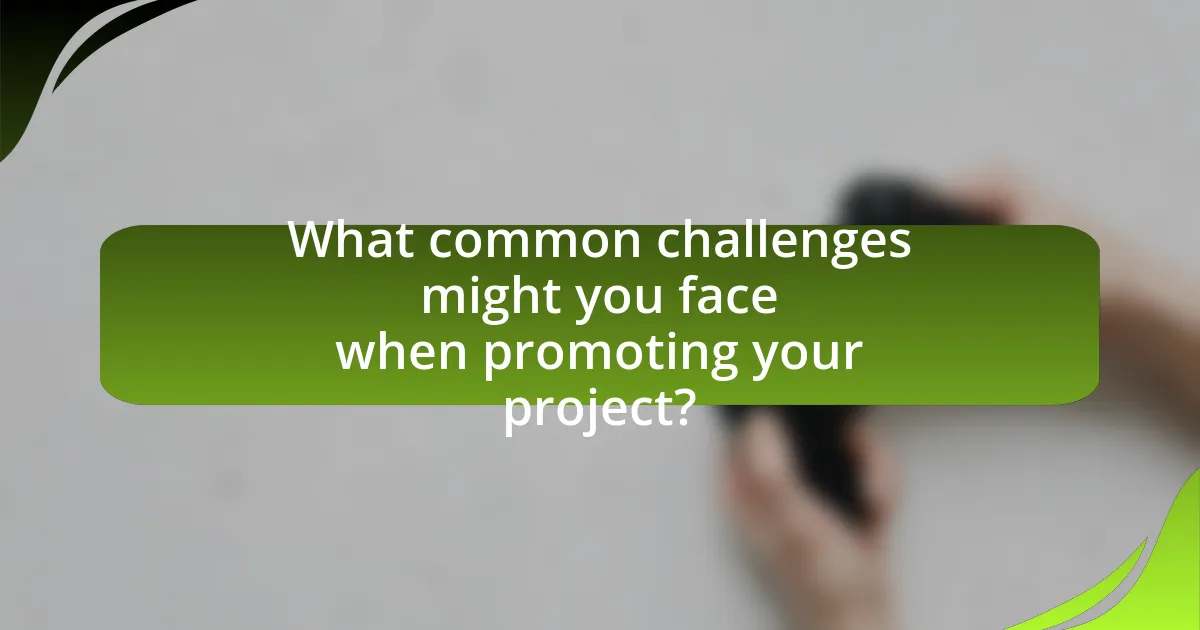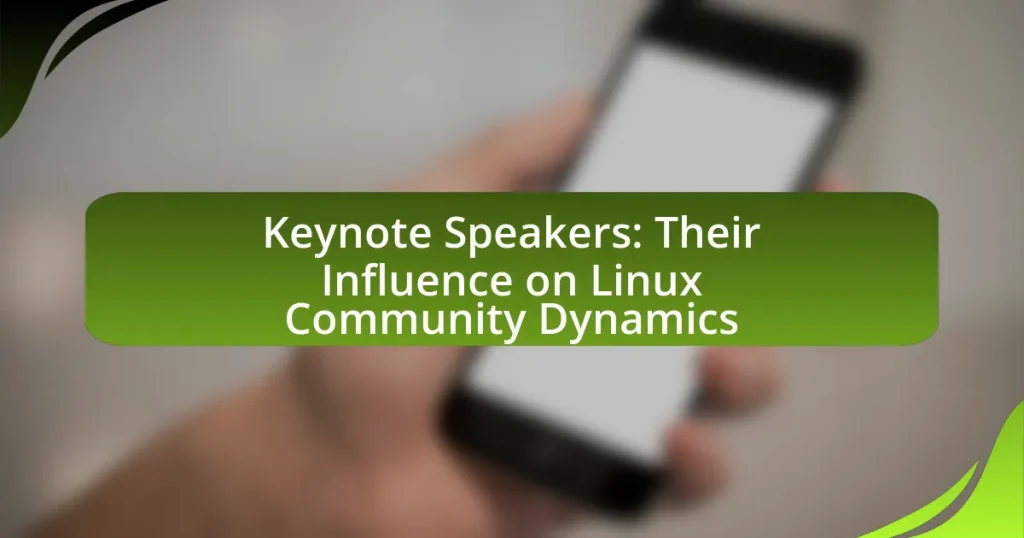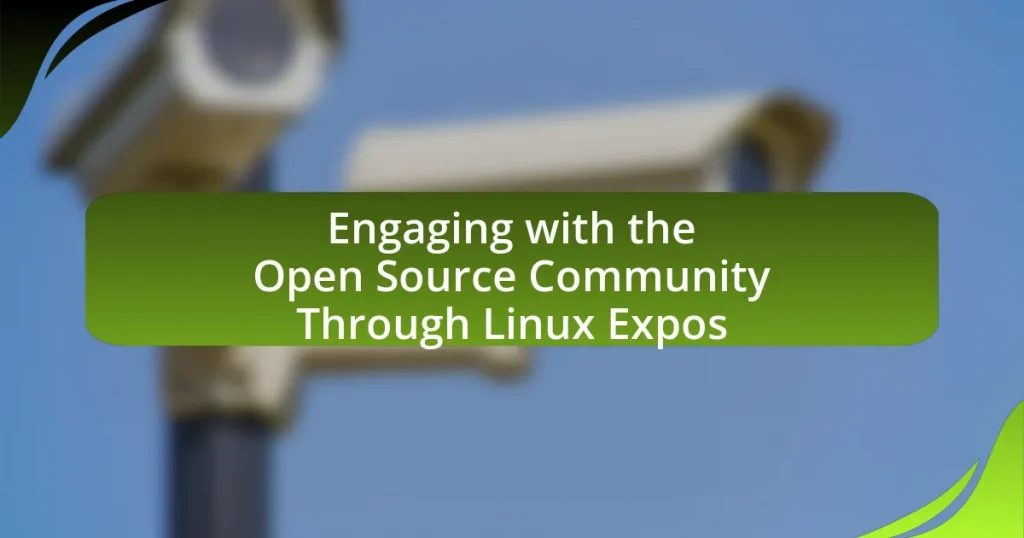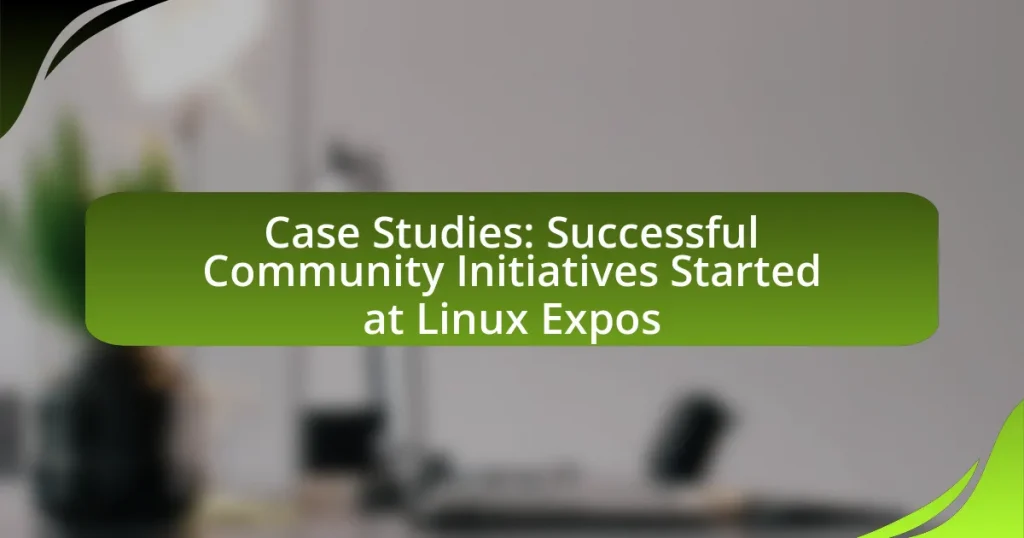The article focuses on effective strategies for promoting projects at a Linux Expo, emphasizing the importance of engaging attendees through interactive demonstrations and clear messaging. Key techniques include utilizing engaging visuals, hands-on workshops, and strategic giveaways to attract visitors to booths. It also highlights the significance of networking with other exhibitors and leveraging social media for increased visibility. Additionally, the article discusses the necessity of preparing promotional materials, measuring success through key performance indicators, and adapting strategies based on attendee feedback to enhance future promotional efforts.

What are the key strategies for promoting your project at a Linux Expo?
To effectively promote your project at a Linux Expo, focus on engaging with attendees through interactive demonstrations and clear messaging about your project’s benefits. Interactive demonstrations allow potential users to experience your project firsthand, increasing interest and understanding. Clear messaging ensures that attendees grasp the value proposition quickly, which is crucial in a busy expo environment. Additionally, utilizing social media before and during the event can amplify your reach, as it encourages attendees to share their experiences and engage with your project online. Networking with other exhibitors and speakers can also lead to valuable partnerships and increased visibility.
How can you effectively engage with attendees?
To effectively engage with attendees, utilize interactive elements such as live demonstrations, Q&A sessions, and hands-on workshops. These methods foster participation and create a dynamic environment that encourages attendee involvement. Research indicates that interactive experiences significantly enhance retention and satisfaction, with studies showing that participants are 75% more likely to remember information presented in an engaging format compared to passive presentations.
What techniques can be used to attract visitors to your booth?
To attract visitors to your booth, utilize engaging visuals, interactive demonstrations, and strategic giveaways. Engaging visuals, such as eye-catching banners and displays, can draw attention from afar, while interactive demonstrations allow potential visitors to experience your project firsthand, increasing interest and engagement. Additionally, offering strategic giveaways, such as branded merchandise or useful tech gadgets, can incentivize attendees to visit your booth. Research indicates that booths with interactive elements see a 50% increase in visitor engagement compared to static displays, highlighting the effectiveness of these techniques in attracting attendees.
How can you create an interactive experience for attendees?
To create an interactive experience for attendees at a Linux Expo, implement hands-on workshops and live demonstrations that engage participants directly. These activities allow attendees to actively participate in learning and exploring the technology, fostering a deeper understanding and connection to the project. For instance, providing coding sessions or interactive Q&A panels can enhance engagement, as studies show that experiential learning increases retention rates by up to 75%. Additionally, utilizing tools like audience response systems can facilitate real-time feedback and interaction, making the experience more dynamic and inclusive.
What promotional materials should you prepare?
To effectively promote your project at a Linux Expo, you should prepare brochures, business cards, banners, and promotional giveaways. Brochures provide detailed information about your project, while business cards facilitate networking and follow-up communication. Banners enhance visibility and attract attendees to your booth, and promotional giveaways, such as stickers or pens, create a lasting impression and encourage engagement. These materials are essential for conveying your message clearly and effectively to the audience at the expo.
What types of brochures or flyers are most effective?
Informational brochures and visually appealing flyers are the most effective types for promoting projects at a Linux Expo. Informational brochures provide detailed content about the project, including features, benefits, and technical specifications, which cater to the audience’s need for in-depth understanding. Visually appealing flyers capture attention quickly with bold graphics and concise messaging, making them ideal for quick distribution and engagement. Research indicates that 70% of attendees at expos prefer materials that are visually engaging and easy to read, enhancing recall and interest in the project.
How can digital content enhance your project’s visibility?
Digital content enhances your project’s visibility by increasing online engagement and reach. When projects utilize blogs, videos, and social media posts, they can attract a larger audience, as 54% of consumers prefer to see video content from brands they support. Additionally, search engine optimization (SEO) strategies applied to digital content can improve search rankings, making it easier for potential users to discover the project. For instance, projects that regularly publish relevant content can see a 434% increase in indexed pages, leading to higher visibility.
Why is networking important at a Linux Expo?
Networking is important at a Linux Expo because it facilitates connections among professionals, developers, and enthusiasts, leading to collaboration and knowledge sharing. These interactions can result in partnerships, mentorship opportunities, and insights into industry trends, which are crucial for project promotion and growth. For instance, according to a survey by the Linux Foundation, 70% of attendees reported that networking at expos significantly enhanced their understanding of open-source technologies and fostered collaborative projects.
How can you build relationships with other exhibitors?
To build relationships with other exhibitors, actively engage in networking opportunities during the event. This can be achieved by initiating conversations, sharing insights about your projects, and expressing interest in their work. Research indicates that 70% of business relationships are built through face-to-face interactions, highlighting the importance of personal engagement at expos. Additionally, collaborating on joint promotions or sharing booth space can foster a sense of community and mutual support among exhibitors.
What role do social media and online platforms play in networking?
Social media and online platforms serve as essential tools for networking by facilitating connections among individuals and organizations within specific communities. These platforms enable users to share information, collaborate on projects, and engage in discussions, thereby expanding their professional networks. For instance, LinkedIn, a prominent professional networking site, boasts over 900 million users, allowing professionals to connect based on shared interests and industries. Additionally, platforms like Twitter and Facebook provide real-time communication and event promotion, which can enhance visibility and engagement during events such as Linux Expos. The ability to join groups, participate in forums, and follow industry leaders further amplifies networking opportunities, making social media and online platforms pivotal in building and maintaining professional relationships.

How can you measure the success of your promotional efforts?
You can measure the success of your promotional efforts by analyzing key performance indicators (KPIs) such as engagement rates, conversion rates, and return on investment (ROI). Engagement rates can be assessed through metrics like social media interactions, booth traffic, and audience feedback during the Linux Expo. Conversion rates can be tracked by monitoring the number of leads generated or sales made as a direct result of the promotional activities. ROI can be calculated by comparing the revenue generated from the promotional efforts against the costs incurred, providing a clear picture of financial effectiveness. For instance, a study by HubSpot found that businesses with defined KPIs are 12 times more likely to achieve their marketing goals, highlighting the importance of measurement in promotional success.
What metrics should you track during the expo?
During the expo, you should track metrics such as attendee engagement, lead generation, brand awareness, and social media interactions. Attendee engagement can be measured through the number of visitors to your booth and the duration of their stay, indicating interest levels. Lead generation can be quantified by the number of contacts collected, which directly correlates to potential future business opportunities. Brand awareness can be assessed through surveys or feedback forms that gauge recognition and recall of your project among attendees. Social media interactions, including likes, shares, and comments related to your expo presence, provide insight into the online impact of your participation. These metrics collectively offer a comprehensive view of your project’s effectiveness in promoting itself at the Linux Expo.
How can attendee feedback inform your future strategies?
Attendee feedback can inform future strategies by providing insights into participant preferences and areas for improvement. Analyzing feedback allows organizations to identify which aspects of their project resonated with attendees, such as specific features or presentations that garnered positive responses. For instance, a study by the Event Marketing Institute found that 70% of event organizers who utilized attendee feedback reported enhanced engagement in subsequent events. This data underscores the importance of feedback in shaping future strategies, enabling organizations to tailor their offerings to better meet the needs and expectations of their audience.
What tools can help you analyze your outreach effectiveness?
Tools that can help analyze outreach effectiveness include Google Analytics, HubSpot, and Hootsuite. Google Analytics provides insights into website traffic and user behavior, allowing you to measure the impact of your outreach campaigns. HubSpot offers comprehensive marketing analytics, tracking email performance and lead generation metrics. Hootsuite enables social media monitoring and engagement analysis, helping you assess the effectiveness of your social outreach efforts. These tools collectively provide data-driven insights that validate their effectiveness in measuring outreach success.
How can follow-up actions enhance your project’s impact?
Follow-up actions can significantly enhance your project’s impact by reinforcing engagement and ensuring sustained interest from stakeholders. When follow-up actions are implemented, they provide opportunities for feedback, which can lead to improvements and adaptations of the project based on stakeholder input. For instance, a study by the Project Management Institute found that projects with effective follow-up strategies are 20% more likely to meet their objectives compared to those without. This demonstrates that consistent communication and engagement after the initial project presentation can lead to better outcomes and increased visibility within the community.
What are the best practices for post-expo communication?
The best practices for post-expo communication include timely follow-ups, personalized messages, and leveraging multiple communication channels. Timely follow-ups should occur within a week after the expo to maintain engagement and capitalize on the interest generated during the event. Personalized messages, tailored to the specific interactions and interests of each contact, enhance the likelihood of a positive response. Utilizing various communication channels, such as email, social media, and phone calls, ensures that the message reaches the audience effectively. These practices are supported by research indicating that timely and personalized communication increases response rates by up to 50%, thereby reinforcing the importance of these strategies in post-expo engagement.
How can you leverage connections made during the expo for future opportunities?
To leverage connections made during the expo for future opportunities, actively follow up with contacts through personalized emails or messages that reference your discussions. This approach fosters relationships and keeps your project top of mind. Research indicates that 70% of professional opportunities arise from networking, highlighting the importance of maintaining these connections. By scheduling follow-up meetings or calls, you can explore collaboration, seek advice, or discuss potential partnerships, thereby maximizing the value of the relationships established at the expo.

What common challenges might you face when promoting your project?
Common challenges when promoting a project include limited visibility, audience engagement, and competition. Limited visibility arises from the vast number of projects presented at expos, making it difficult for any single project to stand out. Audience engagement can be challenging due to varying levels of interest and understanding among attendees, which may hinder effective communication of the project’s value. Additionally, competition from other projects can dilute attention and resources, making it harder to attract potential supporters or collaborators. These challenges are supported by data indicating that over 70% of exhibitors report difficulties in capturing attendee interest at large events.
How can you overcome budget constraints?
To overcome budget constraints, prioritize essential expenses and seek alternative funding sources. Identifying the most critical elements of your project allows for focused spending, while exploring sponsorships, grants, or crowdfunding can provide additional financial support. For instance, many tech expos offer sponsorship opportunities that can significantly offset costs, as evidenced by the Linux Foundation’s support for various open-source projects, which often includes financial assistance for participation in expos.
What low-cost marketing strategies can be effective?
Effective low-cost marketing strategies include leveraging social media platforms, utilizing email marketing, and engaging in community partnerships. Social media platforms like Twitter and LinkedIn allow for targeted outreach to specific audiences at minimal costs, with 73% of marketers believing that their efforts through social media have been “somewhat effective” or “very effective” in promoting their projects. Email marketing, with an average return on investment of $42 for every dollar spent, enables direct communication with interested individuals. Additionally, forming partnerships with local organizations or tech groups can enhance visibility and credibility without significant financial investment, as collaboration often leads to shared resources and audiences.
How can partnerships help mitigate costs?
Partnerships can help mitigate costs by allowing organizations to share resources, expertise, and expenses. For instance, when two companies collaborate on a project, they can split the costs of marketing, logistics, and staffing, which reduces the financial burden on each entity. A study by the Harvard Business Review found that strategic partnerships can lead to cost savings of up to 30% by leveraging combined purchasing power and reducing redundancies in operations. This collaborative approach not only enhances efficiency but also fosters innovation, as partners can pool their knowledge and skills to create more effective promotional strategies at events like Linux Expos.
What should you do if your project doesn’t receive the expected attention?
If your project doesn’t receive the expected attention, you should reassess your promotional strategies and engage with your target audience more effectively. Analyzing feedback from attendees can help identify gaps in your presentation or messaging. Additionally, utilizing social media platforms and community forums relevant to Linux can increase visibility. According to a study by the Pew Research Center, 72% of adults use social media, indicating its potential as a tool for outreach. Engaging with influencers in the Linux community can also amplify your project’s reach, as their endorsement can attract more interest.
How can you adapt your approach in real-time during the expo?
To adapt your approach in real-time during the expo, actively monitor attendee engagement and feedback. By observing body language, listening to questions, and noting the topics that generate interest, you can adjust your presentation style, focus on specific features of your project, or provide additional information that resonates with the audience. For instance, if attendees show more interest in technical details, shift your discussion to those aspects to maintain engagement and relevance. This method is supported by research indicating that adaptive communication strategies enhance audience connection and retention of information.
What lessons can be learned for future events?
Future events can benefit from the lesson that early and strategic planning significantly enhances promotional effectiveness. For instance, establishing clear objectives and target audiences prior to the event allows for tailored messaging and resource allocation, which has been shown to increase engagement rates. A study by Eventbrite revealed that events with a well-defined marketing strategy saw a 30% increase in attendance compared to those without. Additionally, leveraging social media platforms for pre-event buzz can create anticipation and drive participation, as evidenced by the success of various tech expos that utilized targeted social media campaigns to boost visibility and engagement.
What are some best practices for promoting your project at a Linux Expo?
To effectively promote your project at a Linux Expo, engage attendees with interactive demonstrations and provide clear, informative materials. Interactive demonstrations allow potential users to experience the project firsthand, increasing interest and retention of information. Providing clear materials, such as brochures or flyers, ensures that attendees have tangible resources to reference after the event. Additionally, networking with other exhibitors and attendees can lead to valuable partnerships and increased visibility for your project. According to a survey by the Linux Foundation, 70% of attendees value hands-on experiences, highlighting the importance of interactive engagement in promoting projects at expos.
How can you prepare your team for effective engagement?
To prepare your team for effective engagement, conduct thorough training sessions focused on communication skills and project knowledge. This ensures that each team member understands the project intricately and can articulate its value clearly to the audience. Research indicates that well-prepared teams can increase audience engagement by up to 50%, as they are more confident and knowledgeable in their interactions. Additionally, role-playing scenarios can enhance team members’ ability to handle questions and objections, further improving their engagement effectiveness.
What are the key takeaways for maximizing your expo experience?
To maximize your expo experience, prioritize networking, preparation, and engagement. Networking is essential as it allows you to connect with industry professionals, potential collaborators, and customers, enhancing your project’s visibility. Preparation involves researching exhibitors and attendees, setting clear goals, and organizing promotional materials to effectively communicate your project’s value. Engagement is crucial; actively participate in discussions, attend workshops, and showcase your project through demonstrations to attract interest. These strategies are supported by studies indicating that effective networking can lead to increased opportunities and partnerships, while thorough preparation and active engagement significantly enhance attendee satisfaction and project exposure at expos.



